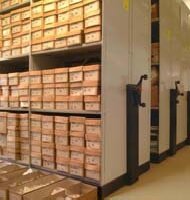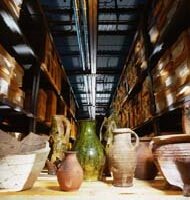Historic Environment Archives and Records


Britain has an unparalleled archival heritage which tells the story of a rich and diverse collective past. The archive is the foundation from which we can build our knowledge of the world around us, including the history of man’s impact on the environment over time. Without archives it would be impossible to know what study took place in the past, what has been found, or how conclusions were drawn.
What are archives?
Historic environment archives are the record of any study undertaken on the effect of man’s involvement in the landscape around him. They include paper, digital and photographic records as well as the physical remains retrieved from excavation in either land or water.
Why archive?
An ‘archive’ is a record of historical importance, which should be preserved for present and future generations. Archives have many uses including professional, academic and personal research, education, outreach and display. They also provide source material for authors, playwrights, artists, broadcasters and journalists and by doing so enrich all our lives. Data on terrestrial and marine archaeology and historic buildings research is vital to inform development control and conservation management decisions.
Historic Environment Archives
The record of man’s activity and its mark on the environment throughout history is an irreplaceable resource. Documents, drawings, photographs and material remains from historic buildings, terrestrial and marine archaeological sites, and landscapes should be prime candidates for archiving, with the presumption to retain unless there are compelling reasons for disposal.
The record of an archaeological site is usually all that remains once an excavation in either land or water is completed, having removed the physical remains of human activity in antiquity. The archaeological archive is therefore a unique record of a historical ‘event’ which has disappeared in any other form. Archaeological archives differ from other more traditional archives in that they incorporate both the physical evidence (finds and environmental samples) as well as the associated records, data and reports that result from a piece of archaeological fieldwork.
Similarly records of historic buildings often describe buildings prior to major changes, for example historic barn conversions, and so provide a visual and written history of our changing world. Landscape studies can provide the most dramatic and fascinating insight into man’s impact on his environment as anyone who has examined any of the vertical aerial photographs taken by the RAF in 1946-8 and covering the nearly whole of England will testify.
Archives are the cornerstone of any project, containing as they do the irreplaceable data and material record of sites, buildings and landscapes that may no longer remain extant. This record is truly the nation’s heritage.
The importance of the archive in the historic environment research and recording process and the contribution it makes to heritage management cannot be over stressed. As we look to the future, it becomes even more apparent that exciting developments in digital access to information and the growing impact of the government’s e-agenda will combine to allow the archive to be explored in ways never before imagined.
Who is responsible for archiving?
Anyone who is involved in undertaking or commissioning research on the historic environment has a duty to ensure all records (including material remains) are appraised with a view to their retention in archive. In addition, in order to complete the local and national record, copies of all reports on recording and analysis (and, where appropriate, initial assessment) of historic buildings, terrestrial and marine archaeology, and landscapes should be submitted to the local Historic Environment Record. If there is any doubt professional help can be sought from the local authority’s conservation/archaeological department, the National Archives at Kew, the local county record office or museum or from within the National Monuments Record (NMR) English Heritage. National guidance prepared by the Archaeological Archives Forum, a consortium of all the major bodies in the UK archaeological sector, has recently been published. ‘Brown, DH. 2007, Archaeological Archives: A guide to best practice in creation, compilation, transfer and curation, Archaeological Archives Forum’. http://www.britarch.ac.uk/archforum/archives/index.html. This a comprehensive, practical and exhaustive guide to the whole process of archaeological archiving for both material and documentary archives, from project planning through to final deposition and the archive’s subsequent curation
Where are archives held?
Most archaeological archives can be found in local and national museums. The NMR holds documentary archives on the historic environment as do a small number of local record offices. The Archaeology Data Service provides access to a growing number of historic environment digital archives via the internet. http://ads.ahds.ac.uk/ . In addition to the archive a record of all works is maintained at a local and national level. Digital data on historic environment investigations, reports submitted as part of the planning process and the results of local research projects are stored by local Historic Environment Records, whilst nationally an index to these works is maintained by the NMR. Local authorities are mainly responsible for maintaining Historic Environment Records (formerly Sites and Monuments Records) for their regions. The HER is generally managed by the local government archaeologist.
Repositories of archives often have standards that must be met in order to deposit an archive. Where these are not stipulated, the guidance stated in ‘1996, Towards an Accessible Archaeological Archive’ Society of Museum Archaeologists’ and ‘2000, Standards in Action’ Museums Documentation Association’ and Brown, D. 2007, Archaeological Archives: A guide to best practice in creation, compilation, transfer and curation, Archaeological Archives Forum’ should be used.
How are archives accessed?
The public and heritage professionals can access this wealth of historical information in a number of ways.
The English Heritage National Monuments Record based at Swindon is a public archive which holds 10 million items dealing with the archaeology, buildings, maritime archaeology and aerial photography of England.
The holdings consist of modern and historic photography, coverage of the whole of England in aerial photographs, a complete set of listed buildings descriptions, data on most known archaeological sites, survey reports on specific buildings and archaeological sites, measured drawings, and a specialist reference library. Some items include an incidental social history component.
Examples of the collection include:
Aerial Photo Collection
680,000 oblique aerial photographs of locations throughout England are available on open access in Swindon. 2,000,000 vertical aerial photographs covering the whole of England, including near-complete coverage taken by the RAF in 1946-8
Public access (‘Red Box’) collections
500,000 photographs of buildings, ranging in date from the 1870s to the 1980s and deriving from various sources. This open access collection is especially strong on ecclesiastical buildings and country houses.
Measured Drawings Collection
56,000 architectural drawings, including plans, elevations, sketches and watercolours, deriving from the RCHME and other sources.
Local Historic Environment Records (HERs) contain information on a wide range of archaeological sites, monuments and landscapes of all periods. Many also contain information on historic buildings and settlements. Historic Environment Records are maintained and managed by local authorities as the essential core of wider historic environment services. , currently planned to go through parliament in the 2008-9 session, proposes to place a statutory duty on all county and unitary Local Authorities to host or have access to an HER. The range of information which an HER currently captures will also extend to cover the wider historic environment.
For anyone interested in finding out more about the archaeology of their local area, including where to find the archives, a good place to start is the County’s Historic Environment Record. Digital access to HERS is becoming more widespread, many HERs are now online and a growing number can be accessed through the Heritage Gateway. It is planned that eventually this portal will provide electronic access to all England’s HERs. HERs are usually primary databases, often linked to GIS systems, which are used extensively for sustainable management of the landscape. They also have a growing role in education and outreach. HERs are staffed by extremely knowledgeable heritage professionals who are able to advise and assist. Many HERs run projects to enhance and synthesise existing data, enabling better presentation to the public and thematic research. Enhancement projects range from area characterisation and period-specific research to mapping.
Local Museums often house archaeological collections which are open to public enquiry and research. There are also one or two specialised centres such as the London Archaeological Archive and Resource Centre (LAARC) in London or the DIG in York which make full imaginative use of the archives involving amateurs, professionals and students in innovative outreach programmes. Centres such as these demonstrate that historic environment archives have immense potential and are a true heritage asset.
Further Details
The NMR archive can be found through on-line searchable databases, for example the Excavations Index ads.ahds.ac.uk/catalogue, which contains archive locations and brief summaries on archive content; Access to Archives (A2A) www.a2a.pro.gov.uk or Pastscape http://www.pastscape.org contacting the NMR directly. The NMR has a public search room.
What's New?
-
Britain was the world’s first industrial nation and has a wealth of industrial heritage but many industrial sites have been lost or are at risk due to functional redundancy. English Heritage's survey has shown that the percentage of listed industrial buildings at risk is three times greater than the national average for listed buildings at risk.
-
The value of a well managed, protected and appreciated historic environment to both our quality of life and to the economy is well established. Heritage tourism contributes £20.6 billion to GDP a year whilst research shows that 93% of people think that in improving their local place it is important to save heritage assets.
